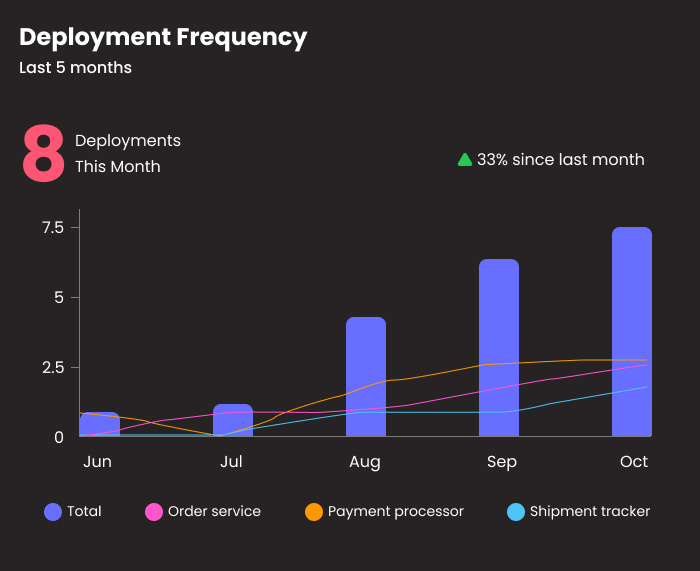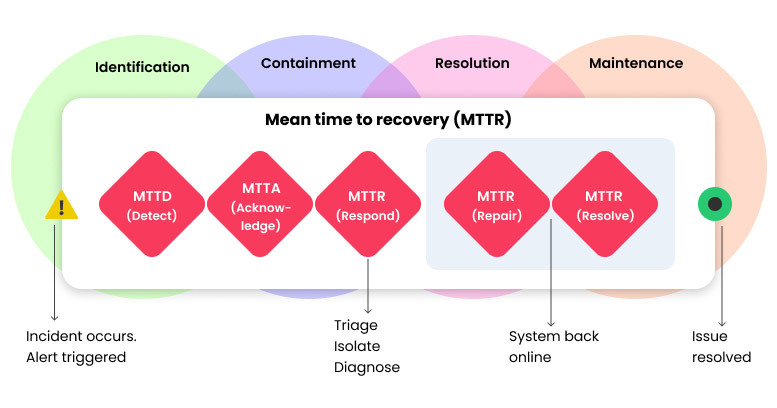DevOps Metrics: 6 Critical Indicators of Performance in 2025

Share This Article
Table of Contents
Subscribe to Our Blog
We're committed to your privacy. SayOne uses the information you provide to us to contact you about our relevant content, products, and services. check out our privacy policy.
What are DevOps Metrics?
DevOps metrics are the statistics, KPI’s and data points that track how effectively a development and operations team is working together. These metrics are the benchmarks for performance, productivity, and the overall health of the DevOps process.
Measuring Up Performance
Why do these metrics matter? Because they provide tangible evidence of how the team is performing. They show you how quickly and reliably you're pushing out updates and if you're doing it without breaking things left and right. It's about finding a balance between speed and quality. By keeping an eye on these metrics, teams can identify bottlenecks, anticipate issues, and adjust their strategies accordingly. Its practical insight, not just numbers, helps teams align their efforts with the end goal satisfied customers and a smooth-running operation.
Here are the Top 6 Critical DevOps Metrics & KPIs to track your team's performance
1. Deployment Frequency

Deployment Frequency stands as a clear indicator of a DevOps team's agility and responsiveness. It tracks how often new code moves from check-in to production, revealing the team's capacity for delivering updates and features to users.
Why Does It Matter?
Frequent deployments can imply a healthier, more responsive development process. It reflects a team's ability to take code from the final commit to a live production environment, thus serving users' needs and addressing issues promptly. Consistent, small updates tend to be less disruptive than larger, infrequent pushes and allow for quicker customer feedback.
Measuring Deployment Frequency
Simply put, it's a count of how often you deploy over a given period. The key is to establish a baseline, monitor changes, and then aim for incremental improvements over time. A dashboard that updates with each deployment can be an effective visual tool.
Best Practices for Improvement
- Automate the CI/CD pipeline to reduce manual errors and save time.
- Keep deployments small to minimize risk and simplify troubleshooting.
- Foster a culture of continuous feedback to identify bottlenecks.
For DevOps teams, improving deployment frequency means becoming more adept at delivering value to users quickly. It's about fine-tuning practices and building on small wins to foster a more nimble, responsive development cycle.
Checkout How Can a DevOps Team Take Advantage of Artificial Intelligence (AI)?
2. Change Lead Time: From Commit to Production
Change Lead Time in DevOps is the duration from code commit to production deployment. It's a clock that starts ticking the moment the new code is merged until it's fully operational in a live environment. It's a snapshot of how swiftly and smoothly a team can deliver new features, fixes, or updates to users.
Change Lead Time's Role in Performance
The speed of this process is a reflection of a team's efficiency and affects everything from user satisfaction to competitive edge. A shorter lead time can mean a faster response to market demands and user feedback, while a longer lead time can suggest bottlenecks or challenges in the workflow.
Cutting Down Change Lead Time
So, how do you shrink this critical time frame? Here are some hands-on strategies:
- Streamline Collaboration: Encourage clear communication between developers, testers, and operations teams to iron out kinks early in the development cycle.
- Automate Testing: Automated tests can run parallel to development, catching issues without manual effort, thus speeding up the process.
- Master the Deployment Pipeline: Employ continuous integration and continuous delivery (CI/CD) tools to ensure that new commits are automatically built, tested, and ready for release.
A speedy, error-free journey from commitment to production is the aim of all development processes, and by tightening up these areas, your DevOps team can make that journey both swift and smooth.
Checkout DevOps VS Agile: Which one to choose & Why
3. Change Failure Rate: Balancing Speed and Stability
Grasping the Change Failure Rate
Change Failure Rate (CFR) is a straightforward yet critical measure, telling us how often deployments or service updates flop, leading to a disruption or a rollback. In DevOps, where the pace is brisk, and the aim is to launch updates quickly, CFR comes in as a sanity check against the rush to deploy.
CFR's Link to DevOps Success
A low CFR is a hallmark of a solid DevOps setup. It shows that not only are you pushing updates at a breakneck speed, but you're also doing it with finesse - minimizing disruptions and maintaining steady service quality. This balance is key; it means fewer headaches for the team and more trust from your users.
Keeping CFR Down Without Losing Speed
So, how do you keep the CFR down without putting the brakes on your deployment train? Here are some pointers:
- Automate Testing: By automating your testing procedures, you can catch slips before they escalate.
- Peer Reviews: Get a fresh set of eyes on code changes; sometimes, it takes a team to spot potential issues.
- Incremental Changes: Small, frequent updates can reduce risks compared to massive, less frequent deployments.
Keeping the CFR in check is not about slowing down; it's about moving forward with confidence.
4. Mean Time to Recovery (MTTR): Responding to Incidents

Why MTTR Matters in DevOps
In the DevOps approach, the MTTR metric is crucial because it quantifies how quickly a team can bounce back from system failures or errors. It's a clear measure of a team's response efficiency, with a direct link to customer trust and service reliability.
Measuring and Decoding MTTR
To get a grip on MTTR, teams clock the time from outage onset to resolution. It's not just about speed; understanding the context behind the numbers is key. A lower MTTR suggests a team that's on their toes, ready to fix issues swiftly, and keep services up and running.
Slash Incident Response Times
Here's is how to improve MTTR with DevOps chops:
- Automate the Mundane: Use automation to detect and address common hiccups without human fuss.
- Practice Makes Perfect: Regular drills for your crew can shave critical minutes off real-life response times.
- Knowledge Share: Maintain a playbook—when the system throws a curveball, your team knows exactly how to swing back.
Quicker recovery times can mean happier customers and a smoother sail for your services.
5. Velocity and Throughput: Metrics for DevOps Efficiency
Velocity is all about the speed at which your DevOps Engineers complete tasks in a sprint or cycle. Throughput moves the focus to the number of tasks or changes pushed to production. Both metrics serve as a speedometer for your workflow, telling you how fast you're going and how much ground you're covering.
Checkout DevOps Project Management: What is the Role & How to Move Pipelines Forward
Why Track These Metrics?
Keeping an eye on Velocity and Throughput keeps your team on track. It's like having a fitness tracker for your DevOps squad. It shows how many 'steps' you're taking and how 'fit' your processes are. You'll spot where you're slowing down and which practices give you an edge.
Optimization Tools and Methods
To kick things up a notch, you've got tools like Jenkins and JIRA aligning your team's rhythm. Continuous Integration and Continuous Deployment (CI/CD) pipelines push for more frequent and reliable releases. And don't forget retrospectives; they're your strategy sessions for refining those workflows.
Tracking these metrics isn't just about numbers, it's about getting your team to ship quality software without the mad dash. It's about keeping pace in a race where endurance beats speed, and steady improvement wins the game.
6. How DevOps Impacts Customer Satisfaction?
DevOps is more than just a method; it's a bridge between the code developers churn out and the end-users who interact with the final product. Quick fixes, fast feature rollouts, and sturdy software are the hallmarks of DevOps that directly touch base with user satisfaction. Happy customers are repeat customers, and they love speedy service, which DevOps delivers by streamlining production cycles.
Tracking Customer Smiles in a DevOps Setup
To get a real sense of how content users are, it's not just about uptime anymore. DevOps teams use direct feedback, response times, and service quality to get a grip on customer happiness. They track how swiftly new features are adopted and how often users come back for more, making sure that the tech heartbeat matches the user's pulse.
How to use DevOps for Better User Experiences?
The aim is to make sure every code commit counts towards a better user click. DevOps doesn't just throw tech at problems; it tunes processes to make sure users get a smooth ride. From the first hello to the last goodbye, DevOps ensures every interaction is quick, smooth, and, most importantly, user-focused. It's about turning user feedback into the next great feature, ensuring the cycle of improvement is unbroken and directly linked to what users are asking for.
Read More on Outsourcing DevOps: What are the Pros & Cons ?
Conclusion: Integrating Metrics into DevOps
Metrics are fundamental to DevOps because they provide clear indicators of where a process stands and what needs to be improved. Think of them as the checkpoint flags in a race, marking progress and signaling the next leg of the journey. With metrics, teams can spot bottlenecks, understand workflow effectiveness, and respond to issues with speed.
At SayOneTech, we cut through the noise to put these metrics to work. We team up with businesses to track critical performance indicators, focusing on real results. This isn't about having the flashiest dashboard; it's about meaningful insights that drive better outcomes.
If you're looking to get a handle on your DevOps strategy, consider SayOneTech. we're in the business of using the best methods to streamline your development and operations so you can deliver software with confidence and clarity. Connect with us to keep your DevOps on track.
Share This Article
Subscribe to Our Blog
We're committed to your privacy. SayOne uses the information you provide to us to contact you about our relevant content, products, and services. check out our privacy policy.
Related Articles

Developer Support for Digital Agencies
Explore The Evolution Of Project Management: Traditional Vs. Devops. Uncover Efficiency, Speed, And Innovation In Just One Click!


